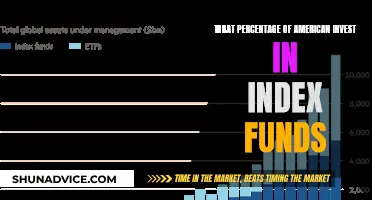
Open-ended mutual funds are a type of investment that pools money from a large number of investors and invests them in different securities, such as stocks and bonds. They are called open-ended because they are always open to investment and redemptions, with no maturity period. This means that investors can buy or sell units of open-ended fund schemes at any time. These funds are priced daily based on their net asset value (NAV), which is the per-unit price at which investors can buy or sell units. Most mutual funds are open-ended funds, and they are bought and sold at their NAV at the end of each trading day.
| Characteristics | Values |
|---|---|
| Definition | A diversified portfolio of pooled investor money that can issue an unlimited number of shares |
| Buying/Selling | Open for buying/selling at any time |
| Maturity Period | No maturity period |
| Investment Period | During the New Fund Offer (NFO) period and after the NFO closes |
| Redemption | Any time based on prevailing NAVs |
| Liquidity | High liquidity |
| Investment Amount | Small investment amount |
| Investment Flexibility | High investment flexibility |
| Ease of Buying/Selling | Can be bought or sold anytime |
| Track Record | Available |
| Pricing | Priced at their portfolio's net asset value (NAV) at the end of each day |
| Trading | Not traded on exchanges |
What You'll Learn

Open-ended funds are always open to investment and redemptions
Open-ended funds are the most common form of investment in mutual funds in India. They are also more common than their counterpart, closed-ended funds, and make up the bulk of the investment options in company-sponsored retirement plans, such as 401(k) plans.
Open-ended funds are highly liquid compared to closed-ended funds. They do not have any lock-in period or maturities, and generally do not have a maximum limit on the amount of investment they can collect from the public. They are priced based on their net asset value (NAV), which is calculated daily on the value of the underlying securities at the end of the day.
When investors purchase shares in an open-ended fund, new shares are created to accommodate them. Investors may redeem shares daily through the administrator, and these shares are bought and sold on demand at their NAV. The fund sponsor sells shares directly to investors and redeems them.
Occasionally, when a fund's investment management determines that its total assets have become too large for its goals, the fund is closed to new investors. In rare cases, the fund's investors instigate the move to become a closed-ended fund.
Mutual Fund Liquidity: Why More Liquid Investments Are Needed
You may want to see also

Open-ended funds are priced only once per day
The daily pricing of open-ended funds means that shares are bought and sold on demand at their NAV. This is calculated at the end of the trading day for mutual funds, based on the value of the fund's underlying securities. If a large number of shares are redeemed, the fund may sell some of its investments to pay the selling investors.
Open-ended funds are priced this way because they are an investment that uses pooled assets, allowing for ongoing new contributions and withdrawals. They can issue an unlimited number of shares, and there is no maturity period, meaning investors can remain in the scheme as long as they want.
Open-ended funds are the most common type of mutual and exchange-traded funds (ETFs). They are popular because they offer investors diversification and flexibility. They are also typically low-cost and have low investment minimums.
Tips Mutual Funds: When to Invest for Maximum Returns
You may want to see also

Open-ended funds are highly liquid
The high liquidity of open-ended funds offers several benefits to investors. Firstly, it provides flexibility, as investors can enter or exit the investment at any time. This flexibility can be particularly advantageous during periods of market volatility or when investors need quick access to their funds. Secondly, open-ended funds typically have low investment minimums, making them accessible to a wide range of investors.
However, the high liquidity of open-ended funds can also present challenges. One of the main challenges is the potential for a liquidity mismatch between the assets and liabilities of the fund. This occurs when the fund invests in less liquid assets but offers daily redemptions to investors. If a large number of investors redeem their shares simultaneously, the fund may be forced to sell its assets quickly to meet these redemption requests, potentially at a lower price than could be obtained through a slower sale. This can result in lower returns or losses for investors.
To mitigate the risks associated with liquidity mismatches, open-ended funds can employ various tools such as swing pricing and notice periods. Swing pricing allows funds to adjust their end-of-day price downward when facing outflows, reducing the incentive for investors to redeem their shares prematurely. Notice periods, on the other hand, introduce a gap between the submission of a redemption request and the pricing and execution of the transaction, giving the fund more time to sell its assets in an orderly manner.
Overall, while open-ended funds offer high liquidity, it is important for investors to carefully consider the potential risks associated with liquidity mismatches and the tools employed by the fund to manage these risks.
Best Vanguard Funds for Your First Investment
You may want to see also

Open-ended funds are the most common form of investment in mutual funds in India
Open-ended funds are a type of mutual fund, which are financial instruments that pool money from a large number of investors and invest them in different securities, such as stocks and bonds. Investors are given units that represent their ownership of the mutual fund scheme's assets. The Net Asset Value (NAV) of these units changes daily based on the stock market movement and changes in bond prices. The NAV is the per-unit price at which investors can buy or sell units of their mutual fund schemes.
Open-ended funds are highly liquid, as they are not bound to any maturity period. They also have a theoretically unlimited number of potential shares outstanding. Most mutual funds and exchange-traded funds (ETFs) are open-ended.
A Beginner's Guide to Index Fund Investment on E-Trade
You may want to see also

Open-ended funds are bought and sold at their net asset value (NAV)
The price of the fund is based on the net asset value of the shares, and the fund sponsor sells and redeems shares directly to investors. This is in contrast to closed-ended funds, which are traded on an exchange and priced according to supply and demand. Closed-ended funds are also subject to wider bid-ask spreads, which can make them more expensive.
Open-ended funds are always open to investment and redemptions, with no lock-in period or maturity date. This means that investors can buy or sell units at any time, excepting certain types of funds, such as Equity Linked Savings Schemes (ELSS) funds, which have a three-year lock-in period.
Open-ended funds are the most common form of investment in mutual funds, and they do not usually have a maximum limit on the amount of investment they can receive from the public. They are also highly liquid, as they can be redeemed at any time, whereas closed-ended funds are only liquid after a specified lock-in period or at fund maturity.
How to Choose the Right Managed Funds
You may want to see also
Frequently asked questions
An open-ended fund is a mutual fund scheme that is open for buying/selling at any time. There is no maturity period in open-ended funds, which means that you can remain invested in the scheme for as long as you want. You can sell units of open-ended funds at any time after investing in them.
You can invest in open-ended mutual funds during the New Fund Offer (NFO) period and after the NFO closes. If you invest during the NFO period, you will be allotted units based on par value or face value. If you invest after the NFO subscription period, you will be allotted units based on the prevailing NAVs.
You can redeem units of your open-ended scheme at any time based on prevailing NAVs. However, if you sell the units of open-ended schemes within the exit load period, then charges may apply.







